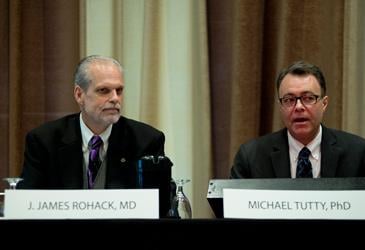When you get home after a day of practicing medicine, how do you feel?
 Physicians spend their days doing extraordinary things providing patient care and should feel wonderful as a result. Instead, they often feel exhausted and overburdened, Michael Tutty, PhD, AMA group vice president for professional satisfaction and practice sustainability, said during a presentation at the 2015 AMA Annual Meeting.
Physicians spend their days doing extraordinary things providing patient care and should feel wonderful as a result. Instead, they often feel exhausted and overburdened, Michael Tutty, PhD, AMA group vice president for professional satisfaction and practice sustainability, said during a presentation at the 2015 AMA Annual Meeting.
So what's causing these pressures?
“It's everything that takes them away from doing those amazing activities,” Tutty said.
Here are three ways the AMA is working to make it easier for physicians to practice so they can focus on patients and relieve some of that stress:
Improved technology
It's no secret that electronic health record (EHR) systems are a huge frustration for physicians, from the technology itself to the regulatory requirements around it, such as the meaningful use program.
To mitigate these problems, the AMA is pushing for better EHR usability, based on a framework it developed with practicing physicians and health IT experts. The AMA also has urged the government to make three key changes to improve the EHR certification process to make the technology easier to use.
It also is aggressively advocating for changes to meaningful use and was successful in securing more flexibility for physicians in Stages 1 and 2.
Help with payment models
New models, such as accountable care organizations, appear to be succeeding, but it depends on how you measure success, Tutty said. How are practicing physicians actually handling these new models?
To find out, the AMA and the RAND Corporation studied physician practices undertaking these new models. The results of that study revealed physicians need help managing and responding to the many quality programs and metrics from payers to ensure long-term sustainability. Read the details of the study at AMA Wire®.
The report's findings will guide the AMA's work in improving alternative payment models and securing the help physicians need to make them successful.
“The lessons learned [from the study] are clear: Changing payment models alone will not get physicians' desired outcomes,” Tutty said.
Guidance for professional relationships
In some areas, physicians and hospitals may be feeling pulled—or pushed—together, said J. James Rohack, MD, a Texas cardiologist and former AMA president who is an advisor for the AMA’s Professional Satisfaction and Practice Sustainability initiative.
To make it a smoother integration, the AMA and the American Hospital Association developed guidelines on how to bring clinical skills and business insights together at the leadership level.
“[Integration] is not for all practices or all places in the country,” Dr. Rohack said. “But there are some that would like to come together and just don't know where to start.”




